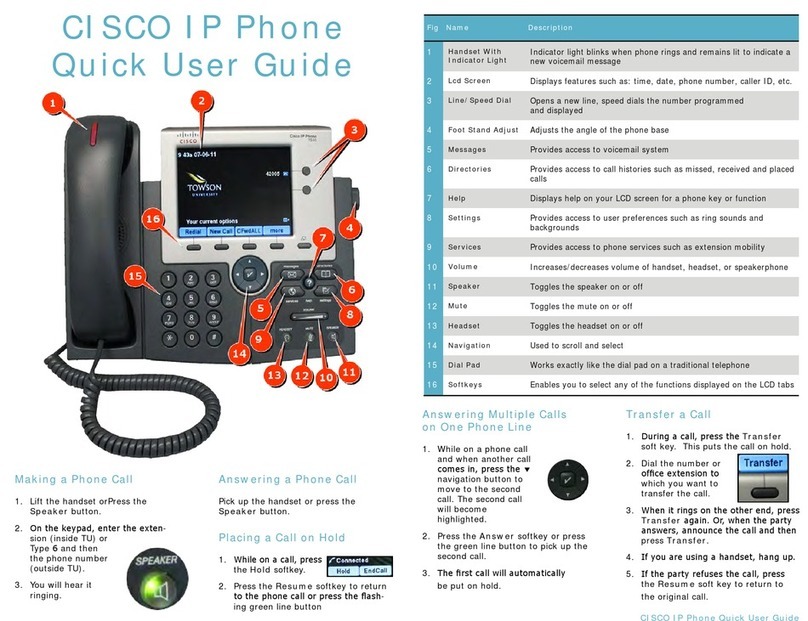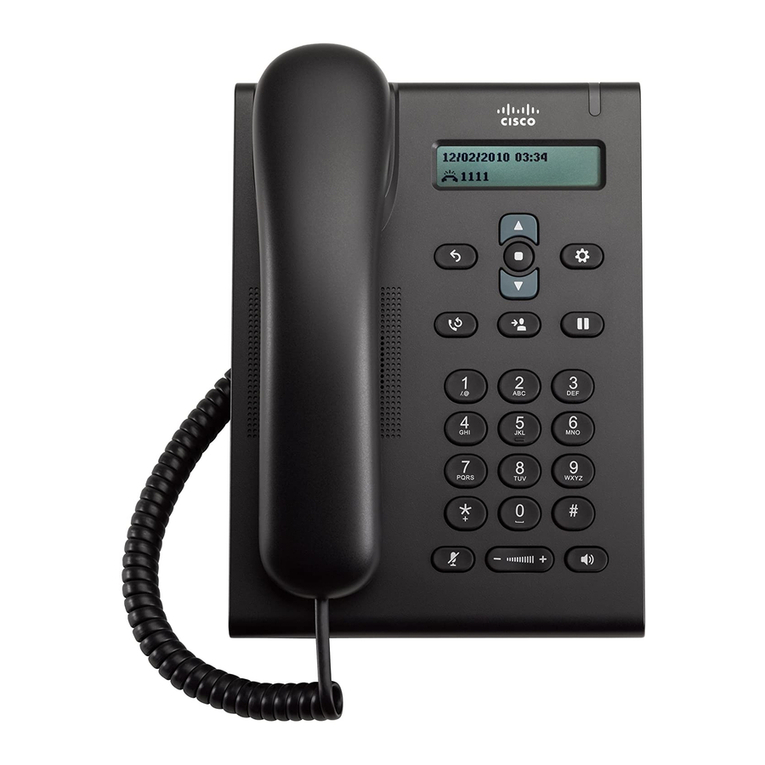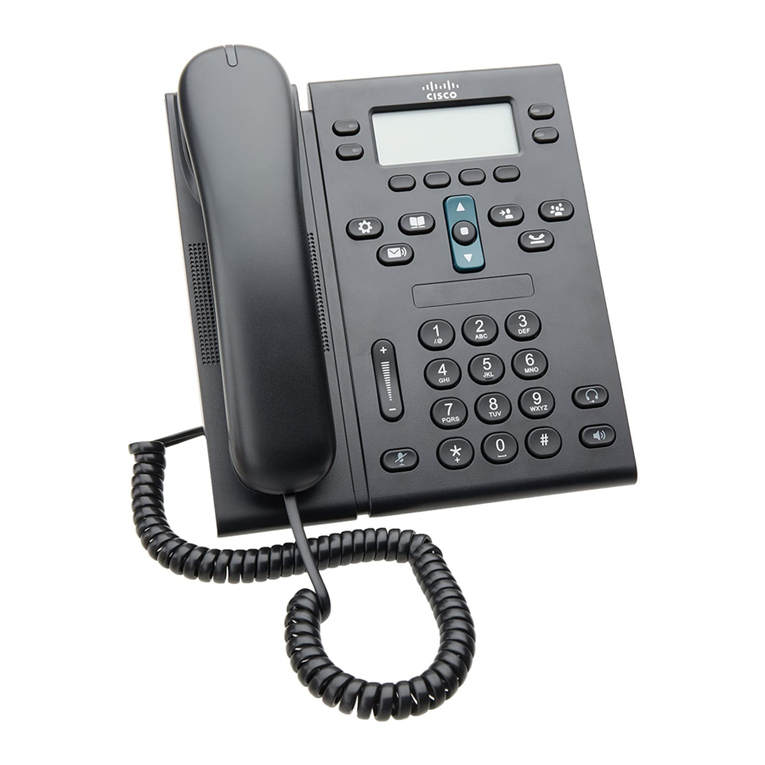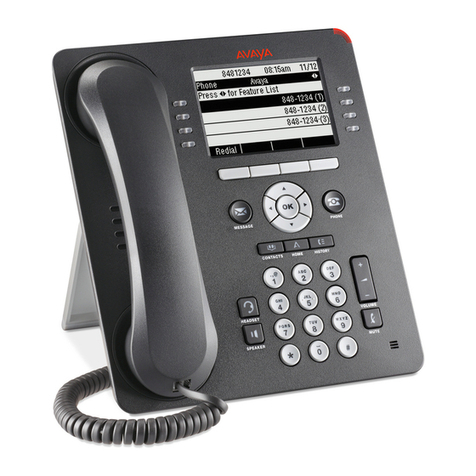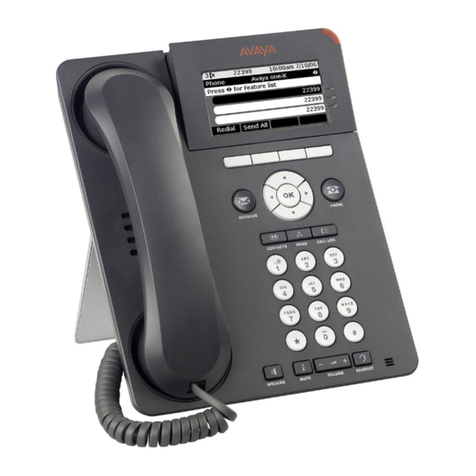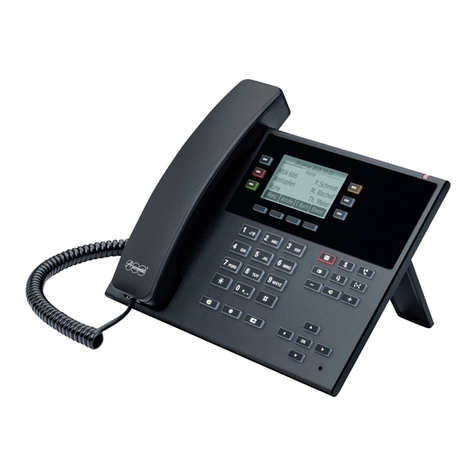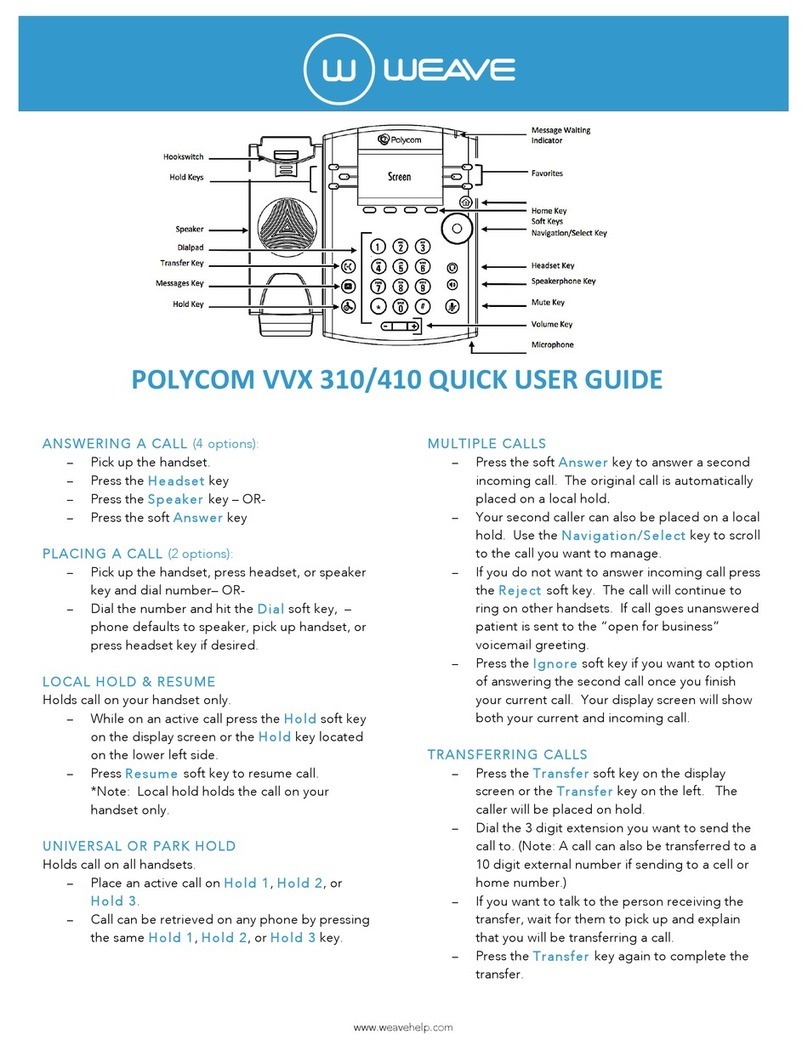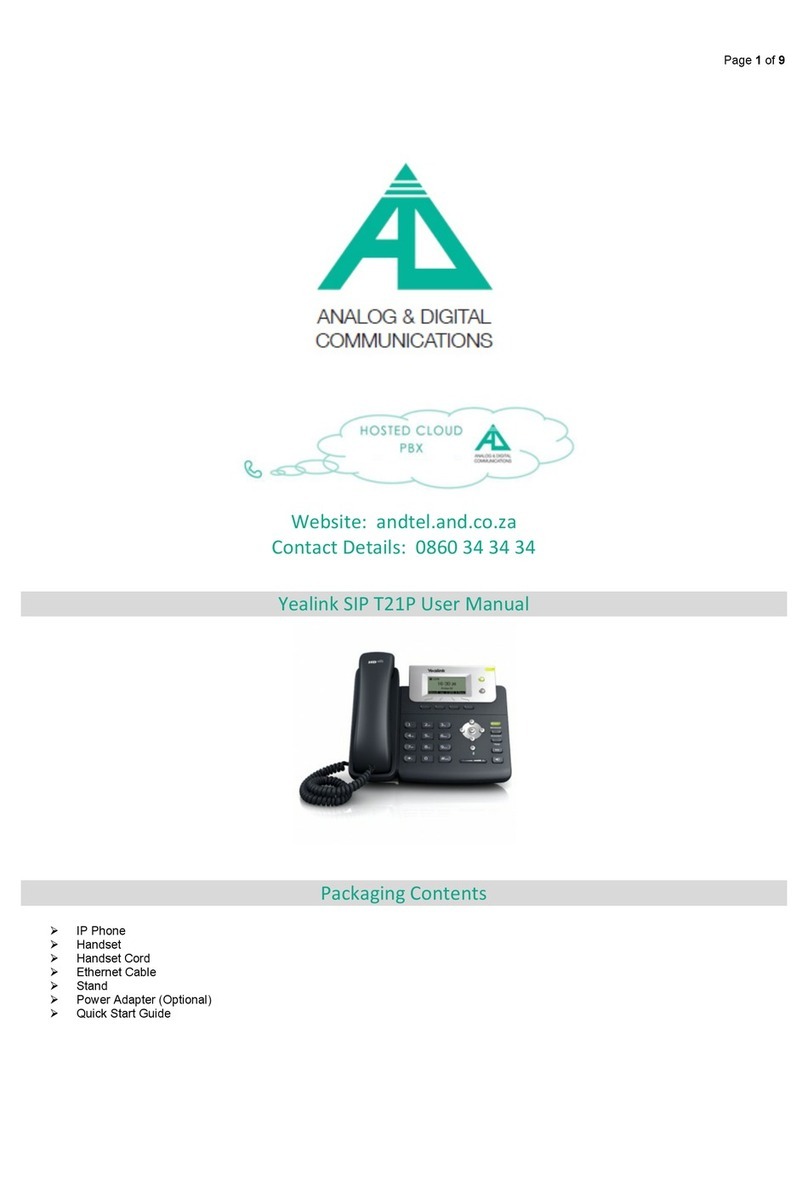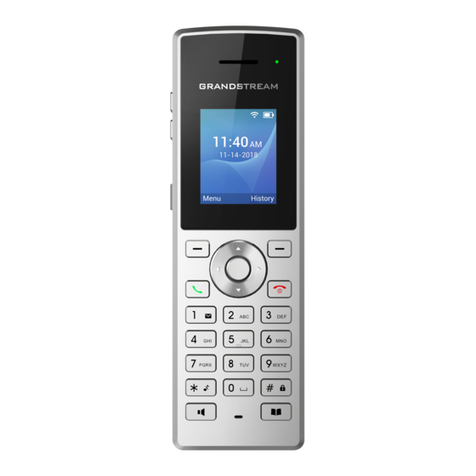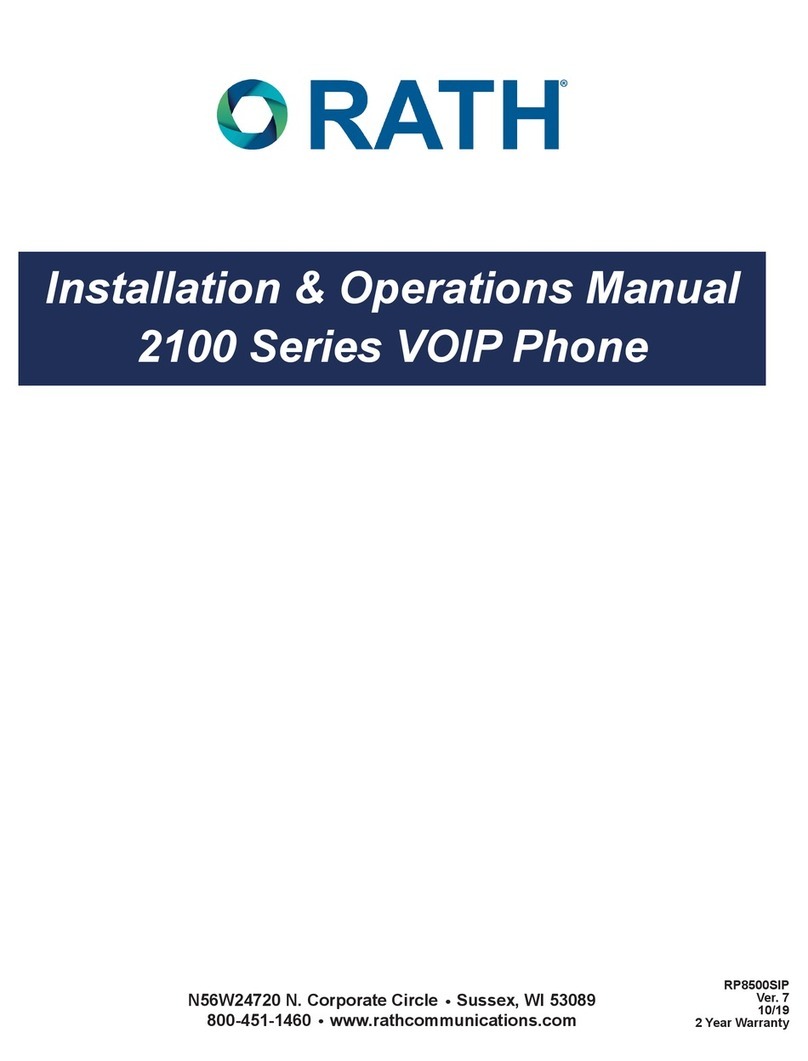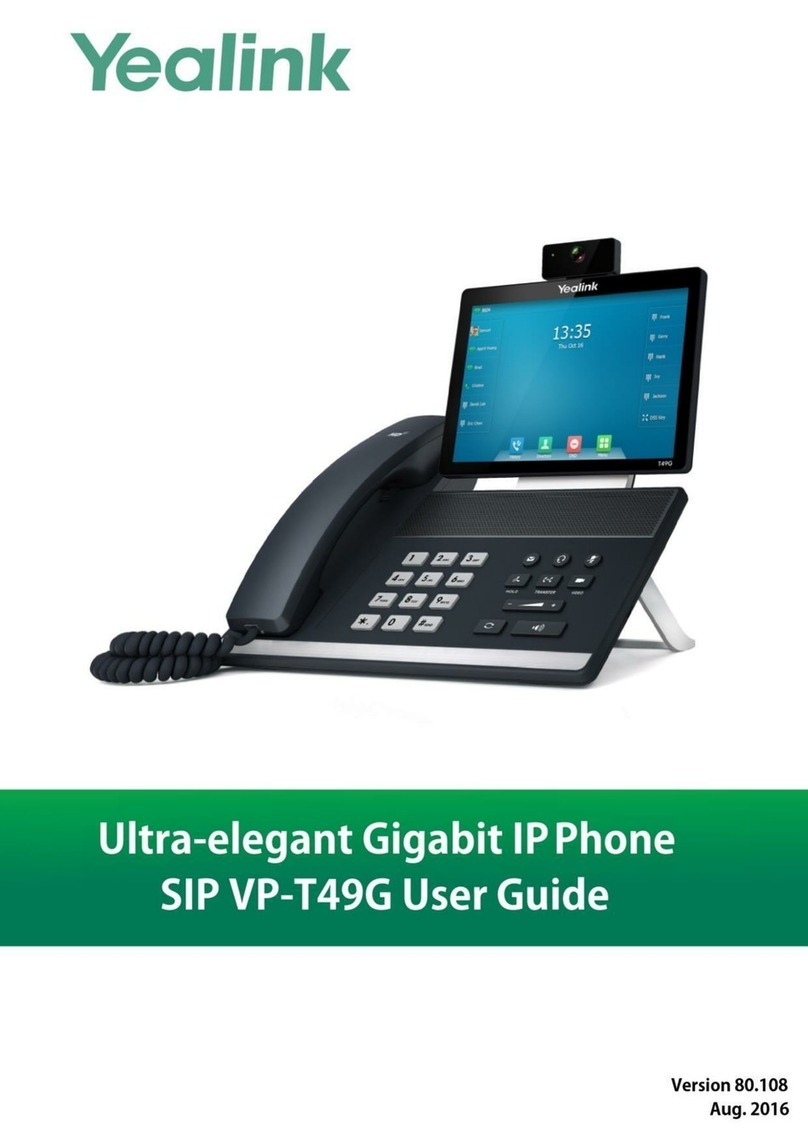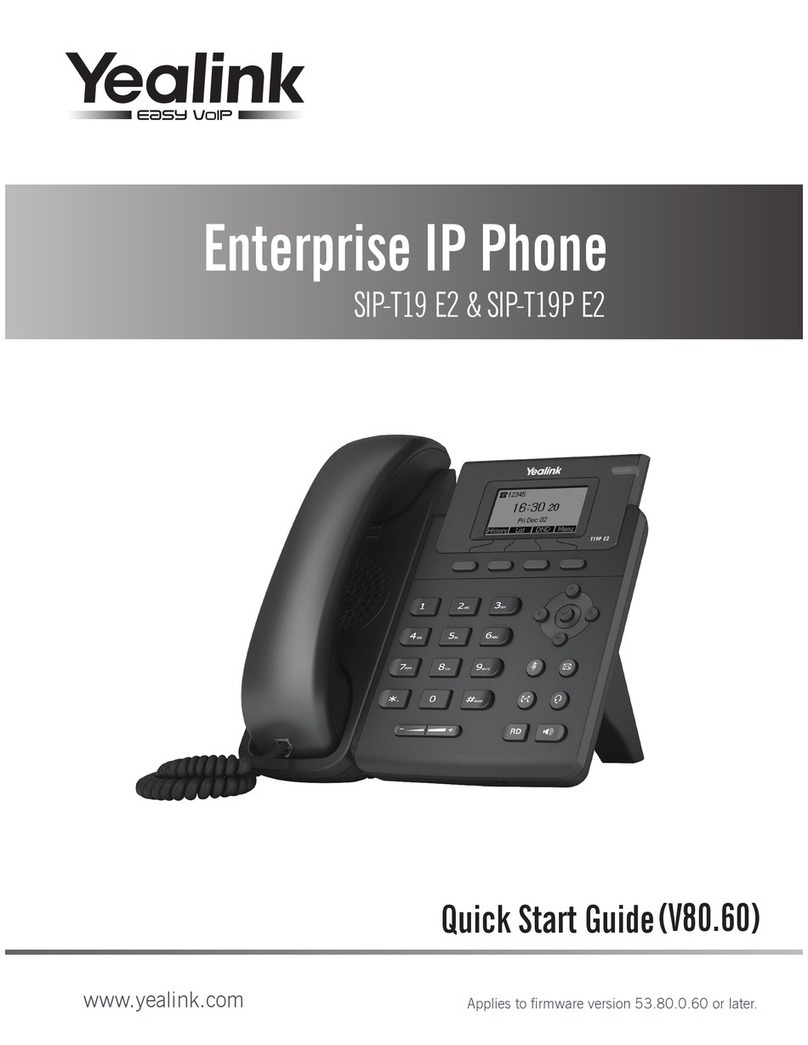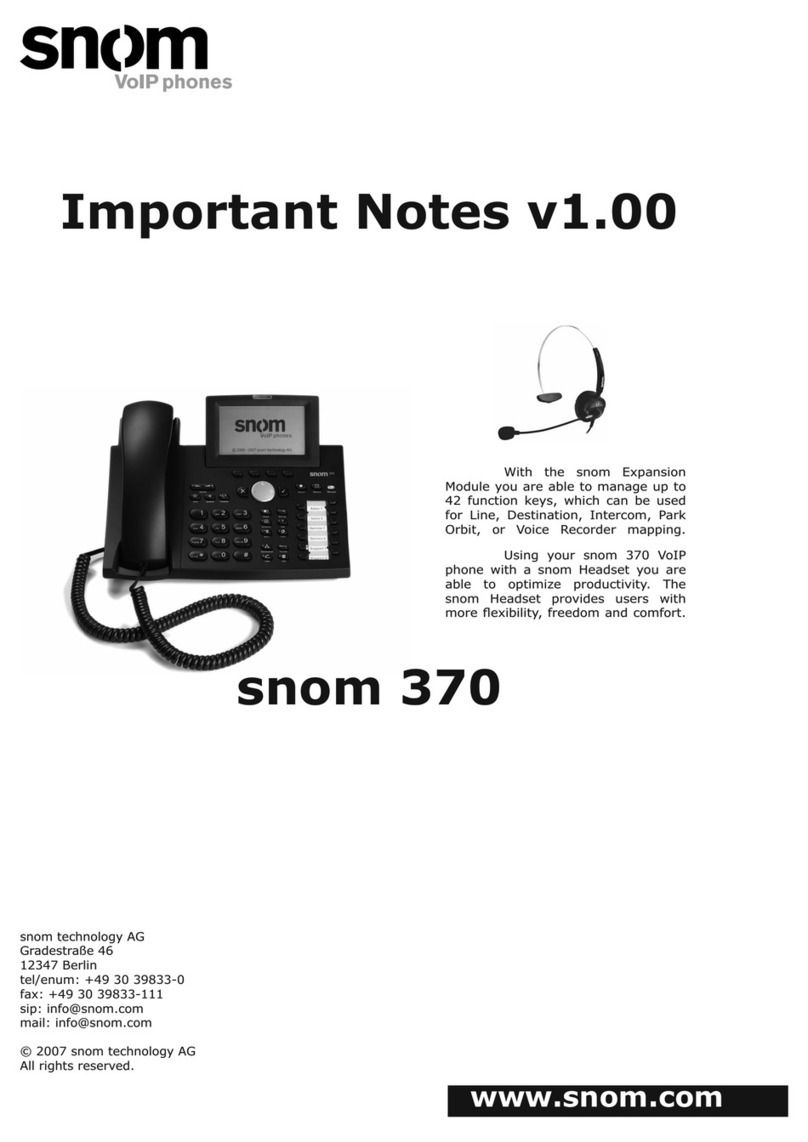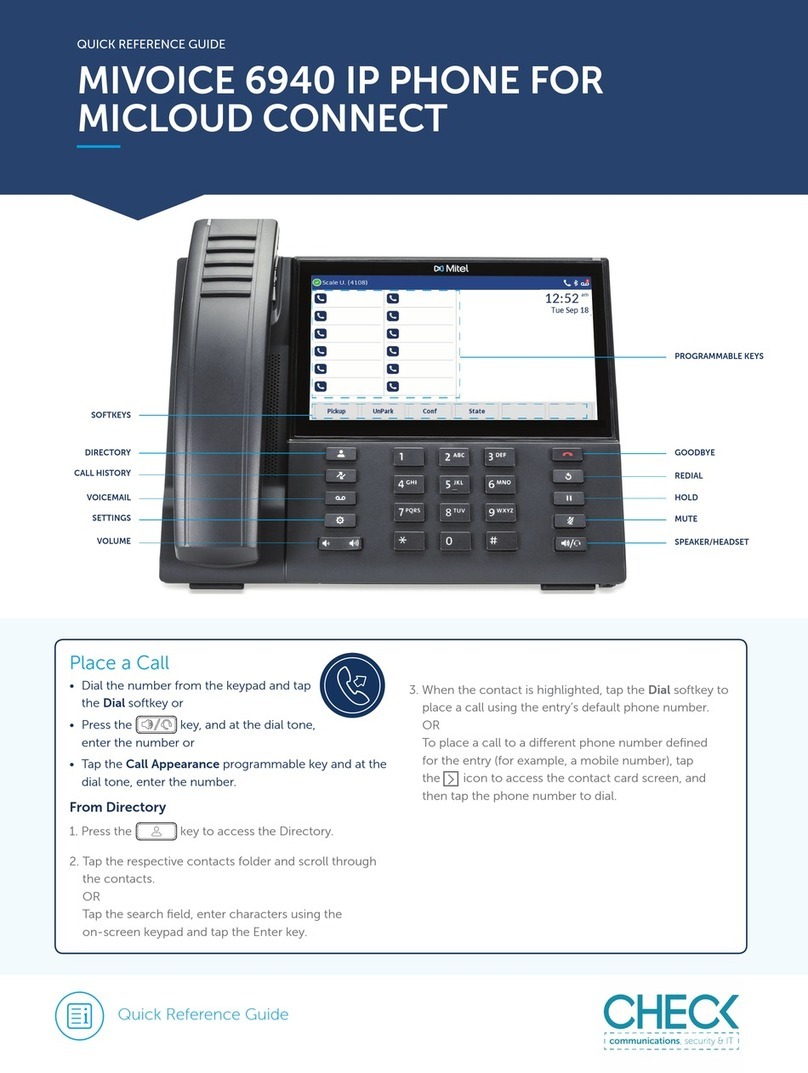Teledex I SERIES User manual

I SERIES VoIP
USER GUIDE
For ND Series, NDC Series, and RediDocks

Important Safety Instructions
When using your telephone equipment, basic
safety precautions should always be followed to
reduce the risk of re, electric shock, and injury
to persons, including the following:
1. Read and understand all instructions.
2. Follow all warnings and instructions marked
on the product.
3. Unplug the product from the wall outlet
before cleaning. Do not use liquid cleaner
or aerosol cleaners. Use a damp cloth for
cleaning.
4. Do not use this product near water—for
example, near a bathtub, wash bowl,
kitchen sink or laundry tub, in a wet
basement, or near a swimming pool.
5. Do not place this product on an unstable
cart, stand, or table. The product may fall,
causing serious damage to the product.
6. Slots and openings in the cabinet and the
back orbottom are provided for ventilation,
to protect it from overheating. These
openings must not be blocked or covered.
The openings should never beblocked
by placing the product on the bed, sofa,
rug,or any other similar surface. This
product should never be place near or over
a radiator or heat register. This product
should not be placed inabuilt-in installation
unless proper ventilation is provided.
7. Never push objects of any kind into this
product through cabinet slots as they may
touch dangerous voltage points or short
out parts that could result in a risk of re
or electric shock. Never spill liquid of any
kind on the product.
8. To reduce the risk of electric shock do
not disassemble this product. Take it to a
qualied service facility if service or repair
work is required. Opening or removing
covers may expose you to dangerous
voltages or other risks. Incorrect
reassembly can cause electric shock when
the appliance is subsequently used.
9. Unplug this product from the wall outlet
and refer servicing to qualied service
personnel under the following conditions:
– When the power supply cord or plug is
damaged or frayed.
– If liquid has been spilled into the product.
– If the product has been exposed to rain
or water.
– If the product does not operate normally
by following the operating instructions.
Adjust only those controls that are
covered by the operating instructions, as
improper adjustment of other controls
may result in damage andmay require
extensive workby a qualied technician to
restore theproduct to normal operation.
– If the product has been dropped or the
cabinet has been damaged.
– If the product exhibits a distinct change
in performance.
10. Avoid using a telephone (other than a
cordless type) during an electrical storm.
There may be a remote risk of electric
shock from lightning.
11. Do not use the telephone to report a gas
leak in the vicinity ofthe leak.
PLEASE SAVE THESE INSTRUCTIONS.
FCC Interference Information
This device complies with Part 15 of the FCC
Rules. Operation is subject to the following two
conditions:
1. This device may not cause harmful
interference.
2. This device must accept any interference
received, including interference that may
cause undesired operation.
This equipment has been tested and found to
comply with the limits for a Class B digital device,
pursuant to Part 15 of the FCC Rules. These limits
are designed to provide reasonable protection
against harmful interference in a residential
installation. This equipment generates, uses,
and can radiate radio frequency energy and, if
not installed and used in accordance with the
instructions, may cause harmful interference
to radio communications. However, there is no
guarantee that interference will not occur in a
particular installation.
2www.teledexeurope.com I SERIES V oIP USER GUIDE

I SERIES V oIP USER GUIDE www.teledexeurope.com 3
If this equipment does cause harmful interference
to radio or television reception, which can be
determined by turning the equipmento and on, the
user is encouraged to try to correct the interference
by oneor more ofthe following measures:
– Reorient or relocate the receiving antenna
for the radio or television that is receiving the
interference).
– Reorient or relocate and increase the
separation between the telecommunications
equipment and receiving antenna.
– Connect the telecommunications equipment
into an outlet on a circuit dierent from that to
which the receiving antenna is connected.
FCC RF Radiation Exposure
Statement
The installation of the base unit should allow
at least 20 centimeters between the base
and persons to be in compliance with FCC RF
exposure guidelines. For body-worn operation,
the portable part (handset) has been tested and
meets FCC RF exposure guidelines.
This device must not be co-located or operating
in conjunction with any other antenna or
transmitter. The changes or modications not
expressly approved by the party responsible for
compliance could void the user’s authority to
operate the equipment.
Industry of Canada Requirements
Note: This equipment meets the applicable
Industry Canada Terminal Equipment Technical
Specications. This is conrmed by the
registration number. The abbreviation, IC, before
the registration number signies that registration
was performed based on a Declaration of
Conformity indicating that Industry Canada
technicalspecicationsweremet.Itdoesnotimply
that Industry Canada approved the equipment.
Before installing this equipment, users should
ensure that it is permissible to be connected to
the facilities of the local telecommunications
company. The equipment must also be installed
using an acceptable method of connection. The
customer should be aware that compliance with
the above conditions may not prevent degradation
of service in some situations.
Repairs to certied equipment should be
coordinated by a representative designated by the
supplier. Any repairs or alterations made by a user
to this equipment, or equipment malfunctions, may
givethe telephone communicationscompanycause
to request the user to disconnect the equipment.
Users should ensure for their own protection, that
the electrical ground connections of the power
utility, telephone lines, and internal metallic
water pipe system, if present, are connected
together. This precaution may be particularly
important in rural areas.
Caution: Users should not attempt to make such
connections themselves, but should contact
the appropriate electric inspection authority, or
electrician, as appropriate.
Notice: The Ringer Equivalence Number (REN)
assigned to each terminal device provides an
indication of the maximum number of terminals
allowed to be connected to a telephone interface.
The termination on an interface may consist of
any combination of devices subject only to the
requirementthatthesumoftheRingerEquivalence
Numbers of all the devices does not exceed 5.
REN: Z
For warranty and service in Canada, please
contact:
Williams Telecommunications
5610 Kennedy Road
Mississauga, Ontario, L4Z2A9
Canada
Phone: 905-712-4242
Fax: 905-712-1754
Requirements of Part 15—
FCC Rules
Note: This equipment has been tested and found to
comply with the limits for a Class B digital device,
pursuanttoPart15oftheFCCRules.Theselimitsare
designed to provide reasonable protection against
harmful interference in a residential installation.

4www.teledexeurope.com I SERIES V oIP USER GUIDE
This equipment generates, uses, and can radiate
radio frequency energy and, if not installed and
usedinaccordancewiththeinstructions, maycause
harmful interference to radio communications.
However, there is no guarantee that interference
will not occur in a particular installation. If this
equipmentdoescauseharmfulinterferencetoradio
or television reception, which can be determined
by turning the equipment o and on, the user is
encouraged to try to correct the interference by one
or more of the following measures:
1. Move the telephone away from the
receiver.
2. Consult the dealer or an experienced
radio/TV technician for help.
Any changes made by the user not approved by
the manufacturer can void the user’s authority to
operate the telephone.
Requirements of Part 68—
FCC Rules
This equipment complies with Part 68 of the FCC
Rules and the requirements adopted by ACTA.
On the bottom of this telephone is a label that
contains, among other information, a product
identier in the format US:AAAEQ##TXXXX. If
requested, this number must be provided to
the telephone company. The USOC Jack for this
equipment is RJ11C.
A plug and jack used to connect this equipment to
the premises wiring and telephone network must
comply with the applicable FCC Part 68 rules
and requirements adopted by ACTA. A compliant
telephonecordandmodularplugareprovidedwith
this telephone. It is designed to be connected to a
compatible modular jack that is also compliant.
See installation instructions for details.
The Ringer Equivalence Number (REN) is used
to determine the number of devices that may be
connectedtoatelephone line. Excessive RENs ona
telephone line may result in the devices not ringing
in response to an incoming call. In most but not
all areas, the sum of RENs should not exceed ve
(5.0). To be certain of the number of devices that
may be connected to a line, as determined by the
total RENs, contact the local telephone company.
For products approved after July 23, 2001, the REN
for this product is a part of the product identier
that has the format US:AAAEQ##TXXXX. The digits
represented by ## are the REN without a decimal
point (e.g., 03 is a REN of 0.3). For earlier products,
the REN is separately shown on the label.
If this telephone causes harm to the telephone
network, the telephone company will notify you
in advance that temporary discontinuance of
service may be required. But if advance notice is
not practical, the telephone company will notify
the customer as soon as possible. Also, you will
be advised of your right to le a complaint with
the FCC if you believe it is necessary.
The telephone company may make changes in its
facilities, equipment, operations, or procedures
that could aect the operation of the equipment.
If this happens, the telephone company will
provide advance notice in order for you to
make the necessary modications to maintain
uninterrupted service.
If trouble is experienced with this equipment, for
repair or warranty information, please contact
Teledex at (800) 462-9446. If the equipment is
causing harm to the telephone network, the
telephonecompanymayrequestthatyoudisconnect
the equipment until the problem is resolved.
There are no user-serviceable parts contained in
this equipment.
Connection to party line service is subject to
state taris. Contact the state public utility
commission, public service commission, or
corporation commission for information.
If your home has specially wired alarm equipment
connected to the telephone line, ensure the
installation of this product does not disable your
alarm equipment. If you have questions about
what will disable alarm equipment, consult your
telephone company or a qualied installer.
This telephone is hearing aid compatible.
These telephone devices are intended for
commercialuseonly,primarilyinhotelguestrooms.
They must be used with a PBX (private branch

I SERIES V oIP USER GUIDE www.teledexeurope.com 5
exchange), and are not intended to be connected
directly to a PSTN line (public switched telephone
network). There are no user-serviceable parts
insidethe equipment.
Technical Specications
This guide covers product made from 2009
forward with a serial number beginning with XX.
For all other models please refer to the Teledex
website for legacy product documentation.
DIMENSIONS
6” (w) x 9” (l) x 3.375” (h)
WEIGHT
With handset: 1.8 lbs.
POWER ADAPTER
7.5VDC 300mA Adapter (for cordless HDKIT)
9 VDC 300mA (Pass through adapter for cordless
telephone)
User Guides
If additional User Guides are needed, please go
to www.teledex.com to download the PDF.
Service
When problems arise that cannot be resolved
using this or related documents, please go to
www.teledex.com/support for information about
customer support, technical support, warranty,
and product returns.
Statement of Limited Warranty
Teledex product warranty information is available
at www.teledex.com.
Converting from Desk to Wall
Mount
The I Series phone can be converted for wall
mounting applications. The conversion is easiest
whenthehandsetandlinecordsarenotconnected.
1. Located on the top of the telephone above
the speaker grill is the wall/desk mount
clip. Remove this clip by rmly pushing
upward (towards the hookswitch).
2. Flip the clip over (top to bottom) so that
the protruding edge is towards the top of
the phone, and reinsert into cutout. This
protruding edge will hold the handset.
3. Turn the telephone over so the bottom is
up, facing you. Place the telephone on a
non-abrasive surface to prevent scratching.
4. Locate and remove the mounting bracket,
rmly push back and pull up to remove two
of the four retaining tabs.
5. Rotate the mounting bracket 180 degrees
clockwise so that the mounting eyelet on
the bracket is facing in the same direction
as the other mounting eyelet located on
the bottom of the telephone.
6. Insert the top two retaining tabs of the
mounting brackets into the mounting
bracket slots (located near the middle of
the telephone). Then rmly push down to
insert the retaining tabs on the opposite
side of the mounting bracket.
7. Connect a short modular line cord into
the jack on the back of the phone (labeled
LINE). Route the line cord through the
line cord channel. Connect the other end
of line cord to the phone jack on the wall
mounting plate.
8. Turn the telephone over, and slide the
telephone down onto the mounting posts
in downward direction. Both eyelets should
line up with the mounting posts.
9. Complete the wall mounting by installing
the handset and handset cord.

Table of Contents
I Series ND and NDC Series 1-Line
VoIP Phone Map .......................... 7
I Series ND and NDC Series 2-Line
VoIP Phone Map ......................... 7
I Series RediDock VoIP Phone Map .......... 8
Functions ............................... 9
Standards and Protocols ................... 9
1. Introduction .......................... 10
1.1 Overview of Hardware ............... 10
1.1.1 ............................. 10
1.1.2 ............................. 10
1.2 Overview of Software ............... 10
2. Handset Keys for I Series ............... 11
2.1 Function Table of Keystrokes ......... 11
2.1.1 MWI—Message Waiting
Indication ......................... 11
2.1.2 Call Volume Control ............ 11
2.1.3 Hold Function ................. 11
2.1.4 Redial Function ............... 11
2.1.5 Speed Dial Keys ............... 11
3. Web Browser User Interface to
Congure the Phone ..................... 12
3.1 Login ............................. 12
3.2 Current Status ..................... 12
3.3 Network .......................... 12
3.3.1 WAN Conguration ............ 12
3.3.2 LAN Conguration ............. 13
3.4 VoIP . . . . . . . . . . . . . . . . . . . . . . . . . . . . . . 13
3.4.1 SIP Conguration .............. 13
3.5 Advance .......................... 16
3.5.1 DHCP Server ................. 16
3.5.2 NAT Conguration ............. 16
3.5.3 STUN Conguration ............ 17
3.5.4 Net Service ................... 17
3.5.5 Firewall Conguration .......... 17
3.5.6 VLAN Conguration QoS
Conguration ...................... 18
3.5.7 Digital Map Conguration ....... 19
3.5.8 Call Service ................... 20
3.5.9 Memory Key Programming ...... 21
3.5.10 MMI Filter ................... 22
3.5.11 DSP Conguration/Audio
Settings .......................... 22
3.6 Conguration Management .......... 22
3.7 Update Firmware ..................23
3.7.1 Update Conguration ........... 23
3.7.2 Autoprovision Firmware
Update ........................... 23
3.8 System Manage .................... 24
3.8.1 Account Manage ............... 24
3.8.2 Syslog Conguration ........... 24
3.8.3 Phone Book .................. 24
3.8.4 Time Set—via Simple Network
Time Protocol (SNTP) ............... 24
3.8.5 MMI Conguration ............. 25
3.8.6 Logout and Reboot System ...... 25
4. Operating Method for Dialing ............ 25
4.1 How to Dial an IP Phone ............. 25
4.2 Set Up the Phone to Register to a SIP
Server ............................... 25
4.2.1 Set the WAN Interface .......... 25
4.2.2 SIP Conguration ............. 26
Reference—Quick Keys ................... 27
Reference—SIP Quick Start to Register
a Single Phone .......................... 28
Program Your Connection Under the
VoIP -> SIP Conguration Screen ......... 28
Speed Dial and OneTouch Message Keys
Are Programmed Under Advance ->
Memory Key .......................... 28
Reset to Factory Default ................ 28
Reference—IP DECT Handset/Base AutoSync
Registration ............................ 29
AutoSync Handset Registration .......... 29
Register Up To 4 Additional Handsets ..... 29
6www.teledexeurope.com I SERIES V oIP USER GUIDE

I SERIES V oIP USER GUIDE www.teledexeurope.com 7
I Series ND and NDC Series 1-Line VoIP Phone Map
I Series ND and NDC Series 2-Line VoIP Phone Map

8www.teledexeurope.com I SERIES V oIP USER GUIDE
I Series RediDock VoIP Phone Map

Functions
•Supportfailover connection to a redundant
SIP server
•SupportNAT (Network Address Translation),
Firewall
•SupportDHCP for phone to accept IP via WAN
port or assign IP address via LAN port
•SupportPPPoE (used when connecting the
ADSL or cable modem)
•Updatethe rmware and/or conguration le
program through HTTP, FTP, and TFTP
•Holdfunction
•Hotlinefunction (dial a specic number as
soon as going o-hook or set a delay before
dialing)
•Speed-dial
•Call-forward,Three-way conference call (in
select 2-line models)
•CallerID display
•DND(Do Not Disturb), Black List, Limit List
•Auto-answer
•Programsettings through a standard web
browser
•Remotemanagement functionality via Telnet
•Classicationmanagement for common
user’s password and superuser’s password
Standards and Protocols
•IEEE802.3 / 802.3 u 10 Base T / 100 Base TX
•PPPoE
•DHCPClient and Server
•SupportG.711a/u,G729, G7231 5.3/6.3 audio
Codec
•SIPRFC3261, RFC 2543
•SupportIAX2
•TCP/IP:Internet transfer and control protocol
(Transport Control Protocol/Internet Protocol)
•RTP:Real-time Transport Protocol
•RTCP:Real-time Control Protocol
•VAD/CNGsave bandwidth (Voice Activity
Detection)
•Telnet:Remote login protocol
•DNS:Domain Name Server
•TFTP:Trivial File Transfer Protocol
I SERIES V oIP USER GUIDE www.teledexeurope.com 9

1. Introduction
This is the User Guide for the I Series VoIP phone.
This phone is a standard SIP (Session Initiation
Protocol) phone, and some conguration is
necessary before it is ready for use. This manual
will illustrate how to set up the phone through
keyboard and Web User Interface (UI).
1.1 Overview of Hardware
1.1.1
The two RJ-45 network interfaces support
10/100M Ethernet. The default WAN interface is a
DHCPClient.TheuserconnectstheWANinterface
to a Power Over Ethernet (POE) enabled switch
to obtain power and an IP address. (Alternatively,
the phone can be assigned a static IP address.)
The LAN port is commonly used for bridging a
guest computer to the network. You can use the
default administrator’s user name “admin” and
password “admin” to login and setup the device’s
conguration.
1.1.2
Only the WAN interface supports POE (802.3af).
1.2 Overview of Software
Network Protocol
•SIP v1 (RFC2543)
•SIP v2 (RFC3261)
•IP/TCP/UDP/RTP/RTCP
•IP/ICMP/ARP/RARP/SNTP
•TFTP Client/DHCP Client/PPPOE Client
•Telnet/HTTP Server
•DNS Clients
Codec
•G.711: 64K bit/s (PCM)
•G.723.1: 63k/5.3k bit/s
•G.726: 16k/24k/32k/40k bit/s (ADPCM)
•G.729A: 8k bit/s (CS-ACELP)
•G.729B: Adds VAD & CNG to G.729
Voice Quality
•VAD: Voice Activity Detection
•CNG: Comfortable Noise Generator
•LEC: Line Echo Canceller
•Packet Loss Compensation
•Adaptive Jitter Buer
Call Function
•Call Hold •Call Forward
•Call Waiting •Three-way Conference
Tone
•Ring Tone •Dial Tone
•Ring Back Tone •Busy Tone
Phone Function
•Volume Adjustment •Phone Book
•Speed Dial Key
IP Assignment
•IP (Static IP) •DHCP •PPPoE
Security
•HTTP 1.1 Basic/Digest Authentication Web
Setup
•MD5 for SIP Authentication (RFC2069/
RFC2617)
QoS
•QoS Field
NAT Traversal
•STUN
Conguration
•Web Browser •Console/Telnet •Keypad
DTMF
•DTMF RELAY •DTMF SIP Info
•DTMF RFC 2833
SIP Server
•Support two SIP servers working at the
same time
•Provide a backup SIP server
Firmware Upgrade
•TFTP •HTTP •FTP
10 www.teledexeurope.com I SERIES V oIP USER GUIDE

2. Handset Keys for
2.1 Function Table of Keystrokes
Name Status Function/Display
Hold Call Hold on
MWI On-Hook Press ashing
light to retrieve
messages
Mute Press Mute voice path
Redial Call/
Dialing
Call the number
dialed last time
Spkr Speaker
Volume + Call Increase the volume
Volume – Call Decrease the
volume
M1–M10 On-Hook 10 speed dial
numbers
1 Dialing “1”
2 Dialing “2”
3 Dialing “3”
4 Dialing “4”
5 Dialing “5”
6 Dialing “6”
7 Dialing “7”
8 Dialing “8”
9 Dialing “9”
0 Dialing “0”
* Dialing “*”
# Dialing It can be regarded
as the rst number
being dialed out or
the end mark for
ending number
INDICATION
The Messages key serves as an indicator that
messages are present as well as a speed dial
key to dial in and retrieve those messages. If
messagesarepresent,presstheashing red MWI
key labeled Messages to go o-hook and dial the
programmed voicemail number. First, program
the speed dial to the correct voice mail port of
your PBX in the Web UI (found under Advanced ->
Memory Key -> MWI Number).
2.1.2 CALL VOLUME CONTROL
Press “Volume +” to increase the volume and
“Volume –“ to decrease the volume.
2.1.3 HOLD FUNCTION
Hold the current line’s call.
2.1.4 REDIAL FUNCTION
Redial the last number dialed.
2.1.5 SPEED DIAL KEYS
The I Series phone has 10 speed dial keys
programmable through the Web UI under
Advanced -> Memory Key.
I SERIES V oIP USER GUIDE www.teledexeurope.com 11

12 www.teledexeurope.com I SERIES V oIP USER GUIDE
3. Web Browser User
Interface to Congure
the Phone
In most cases, the phone will obtain an IP
address from the local DHCP server. You may
nd this IP address from the phone by using a
simple diagnostic code. On the phone’s dialpad,
press * * 4 7 # (* * I P #). The phone will read
out the IP address (and display it on the LCD if
the phone has a screen). To access the phone,
it is necessary that your computer’s IP is on the
same network with the phone IP, so make sure
it gets a compatible IP address within the same
network. Then open a web browser, input the
phone’s IP address in the address eld, and you
will enter the web-based User Interface pages of
3.1 Login
The default Username and Password are admin/
admin and guest/guest.
3.2 Current Status
The Current Status page shows the working state
of the VoIP phone. The network part shows the
connection state of the WAN interface and the
LAN interface as well as the network setting
(DHCP or Static): the MAC address of the phone
and the Firmware version. Here you can also see
whether the phone is registered to the IP/PBX
server or not. The Phone Number section shows
the telephone numbers in SIP Line 1 and SIP Line
2. (SIP Line 2 is commonly used as a failover to a
second IP/PBX in case of emergency.)
3.3 Network
3.3.1 WAN CONFIGURATION
WAN PORT NETWORK SETTING PAGE
Supports Static IP, DHCP (Dynamic Host Control
Protocol), and PPPoE.
CONFIGURE STATIC IP
– Enable Static
– Set I Series’ IP address in the IP Address eld
– Set the Subnet mask in the Netmask eld
– Set router IP address in the Gateway eld
– DNS Domain
– Set local DNS server IP addresses in the
Primary DNS and the secondary IP address in
the Alternate DNS eld

I SERIES V oIP USER GUIDE www.teledexeurope.com 13
Congure to dynamically obtain the IP.
Enable DHCP.
If there is a DHCP server in your local network,
the I Series phone will automatically obtain the
WAN port network information from your DHCP
server.
CONFIGURE PPPOE
– Enable PPPoE
– PPPoE Server: Enter “ANY” if not specied
from your ITSP
– Enter PPPoE username and pin in the
Username and Password entries
The I Series phone will automatically obtain the
WAN port network information from your ITSP
if the PPPoE setting and the setup are correct.
Note: If a user accesses the IP phone through
a WAN port he or she should use the new IP
address to access the IP phone when the WAN
port address was changed.
3.3.2 LAN CONFIGURATION
LAN IP: This is where you can set the IP address
of the phone (at its LAN port). This is seldom used
because in most environments Bridge Mode is
enabled, causing the LAN port to act as a bridged
extension of the WAN port.
Netmask: Set the IP Subnet mask for the LAN.
DHCP Service: Enable DHCP service on the LAN
port. After the user changes LAN IP, the phone
will automatically modify the DHCP Lease Table
and save the conguration according to the IP
and netmask information. The DHCP server
conguration won’t take eect until you reboot
the device.
NAT: Enable Network Address Translation (NAT)
for navigating through rewalls.
Bridge Mode: Enable this option to switch to
Bridge Mode. An IP phone won’t assign an
internally generated IP for its LAN port in Bridge
Mode. Most hotel properties will bridge the LAN
and WAN port, but separate the Guest network
from the Hotel’s IP/PBX by implementing VLANs
(Virtual LAN’s). (This setting won’t take eect
unless you save the conguration and reboot the
device.)
3.4 VoIP
3.4.1 SIP CONFIGURATION
SETTING PAGE OF PUBLIC SIP SERVER
Server Address: The IP address of the SIP server
that the SIP phone will attempt to register to.
Server Port: The Internet Socket Port number
of the SIP registration server. The default port is
5060.
Account Name: Username of your SIP account.
(Usually the same as the phone number.)
Password: Password of your SIP account.
Phone Number: Phone number of your SIP
account.

14 www.teledexeurope.com I SERIES V oIP USER GUIDE
Enable Register: Enable/Disable SIP register.
The I Series phone won’t send registration
information to the SIP server if the register is
disabled.
Display Name: This eld will display the User
Agent (UA) in the header.
Proxy Server Address: IP address of proxy SIP
server. (A SIP provider usually uses the same IP
for the register server and the proxy server. In
this case you don’t need to congure the proxy
server information.)
Proxy Server Port: Signal port of the SIP proxy.
Proxy Username: Proxy server username.
Proxy Password: Proxy server password.
Domain Realm: SIP domain—enter the SIP
domain if any. Otherwise, the I Series phone will
use the proxy server address as the SIP domain.
Enable Message Waiting: The conguration
allows or forbids Message Waiting.
ADVANCED SIP SETTING
Advanced SIP Settings rarely need to be changed.
Most of the settings should be left at Default, and
many are not applicable to hospitality phones.
Two of the settings you may (in rare instances)
need to change are DTMF Mode and Forward
Type (however, forwarding in hospitality is usually
handled by the PBX).
Register Expire Time: Registration expiration
time. The default is 60 seconds. The I Series
phone will automatically congure this expire
time to the server recommended setting if it is
dierent from the SIP server.
Forward Type: Call forwarding has three types:
Always, Busy, and No Answer. You may select
the type of forwarding here, and then you must
complete the conguration by Disabling Call
Waiting (Found in Advanced -> Call Service).
No answer: If no answer after a set period of
time(No AnswerTimeis foundinAdvanced->
Call Service) it will forward to the appointed
phone.
Always: The caller is always forwarded to
the appointed phone.
NAT Keep Alive Interval: The Network Address
Translation (NAT) is the process of modifying IP
address information in IP packet headers while
in transit across a trac routing device. Keep
Alive is a method of maintaining that the service
remains active.
Forward Phone Number: The designated phone
number calls will forward to.
User Agent: The User Agent (UA) is an identier
for the phone and is part of the SIP Header used
with every packet.
Server Type: The particular IP/PBX system
supplier carries out the sign and speeches to
encrypt. The default is COMMON and should
always be used.
Signal Key: Not applicable in Hospitality
environments.
DTMF Mode: DTMF (Dual Tone Multi-Frequency)
signal sending mode: supports RFC2833, DTMF_
RELAY (inband audio), and SIP information where
DTMF is sent as a SIP message. (DTMF is the
acronym for the tones that are send from the
number dialpad.)
DTMF SIP INFO Mode: DTMF Tones can
be sent as SIP messages as well as audio
streamed tones. SIP INFO mode has two
dierentiations in this drop-down menu.
The default of “Send 10/11” is recognized by

I SERIES V oIP USER GUIDE www.teledexeurope.com 15
most IP/PBXs, but some vendors (Avaya CM)
recognized “Send */#”.
Media Key: Not applicable in Hospitality
environments.
RFC Protocol Edition: SIP versions are identied
by the IETF (Internet Engineering Task Force).
SIP version 1 is RFC 2543. The default is the
newer SIP 2 RFC 3261. An example of when
you might revert back to RFC2543 is if the gate
needs to communicate to older devices (such as
CISCO5300) using the SIP 1.0 (RFC2543 protocol).
Default is RFC 3261.
Local Port: The Standard Internet Port for SIP
signaling is 5060. However, sometimes these
port numbers are changed to enhance security.
They would be changed in Basic Settings as well
as in Advanced Settings.
Transport Protocol: Default is UDP (User
Datagram Protocol) and should be used instead
of the TCP (Transport Control Protocol) option.
Ring Type: The alerting ring that the phone
presents to the called party is set here. Default is
the USA conventional ring Type 1.
Subscribe Expire Time: Message Waiting
Indication is an event package that must be
subscribed to. The default is 300 seconds to
check and re-subscribe with the server.
Enable Subscribe: Enable the subscription to the
voice mail service.
Enable URI Convert: Default is enabled/checked.
A Uniform Resource Identier (URI) is a string of
characters used to identify a name or a resource.
Such identication enables interaction with
representations of the resource over a network
(typically the World Wide Web) using specic
protocols. Leave this parameter selected.
Enable Keep Authentication: Not applicable
in Hospitality environments. The default is
unchecked.
Signal Encode: Not applicable in Hospitality
environments. The default is unchecked.
NAT Keep Alive: Usually not applicable in
Hospitality environments. The default is
unchecked.“KeepAlive”isatermusedtodescribe
the act of keeping a persistent connection. Ports
are opened and closed in IP communications.
A keep-alive prompt/command ensures the
connection is NOT dropped, but is instead kept
open. When the client sends another request,
it uses the same connection. This will continue
until either the client or the server decides that
the conversation is over, and one of them drops
the connection.
Rtp Encode: Not applicable in Hospitality
environments. Video H.273 encode related.
Enable Via Rport: Default is enabled/checked.
This checkbox enables or disables rport
parameter for the Via header eld. The default
setting allows a client to request that the server
send the response back to the source IP address
and port from which the request originated.
However, in some environments it might be
desired to switch this parameter o.
Enable Session Timer: Default is unchecked. Not
applicable in Hospitality environments.
Enable PRACK: Default is unchecked/disabled.
SIP PRACK (Provisional Acknowledgement) is a
way to enable reliability for SIP 1xx messages like
180 ringing and 183 session in progress. PRACK
messages ow from calling party to called party.
PRACK reliability has been found to be important
in several cases, including interoperability
scenarios with the PSTN and Proxy servers with
SIP v1 RFC2543. The default is DISABLED.
Answer with Single Codec: Not applicable
in Hospitality environments. The default is
unchecked/disabled.
Long Contact: Not applicable in Hospitality
environments.Thedefaultisunchecked/disabled.
Auto TCP: Not Applicable in Hospitality
environments.Thedefaultis unchecked/disabled.
Auto TCP refers to TCP Auto-tuning. TCP tuning
techniques adjust the network congestion

16 www.teledexeurope.com I SERIES V oIP USER GUIDE
avoidance parameters of TCP connections over
high-bandwidth, high-latency networks.
Click to Talk: Not applicable in Hospitality
environments.Thedefaultis unchecked/disabled.
3.5 Advance
3.5.1 DHCP SERVER
DHCP SERVER MANAGE PAGE
User may trace and modify DHCP server
information on this page.
DHCP Lease Table: Displays the IP-MAC
corresponding table that the server distributed.
Lease Table Name: Lease table name.
Start IP: The starting IP of the lease table or
DHCP Scope.
End IP: The ending IP of the lease table or DHCP
Scope. Any network device connecting to the
the IP range between the start IP and the end IP.
Lease Time: DHCP server lease time dening
how long the IP address handed out to the
network device is valid.
Netmask: Subnet mask of the lease table.
Gateway: Default gateway of the lease table.
DNS: Default DNS (Domain Name Server) of the
lease table.
DNS Relay: Enables the Domain Name Server
relay function.
DHCP Lease Table: Shows the IP-MAC
corresponding table assigned by the DHCP
server.
Note: This setting won’t take eect unless you
save the conguration and reboot the device.
3.5.2 NAT CONFIGURATION
ADVANCE NETWORK ADDRESS TRANSLATION
(NAT) SETTING
Maximum of 10 items for TCP and UDP port
mapping.
IPSec ALG: Enable/Disable IPSec ALG.
FTP ALG: Enable/Disable FTP ALG.
PPTP ALG: Enable/Disable PPTP ALG.
Transfer Type: Transfer type using port mapping.
Outside Port: WAN port for port mapping.
Inside IP: LAN device IP for port mapping.
Inside Port: LAN device port for port mapping.
Click Add to add new port mapping item and
Delete to delete current port mapping item.
DMZ CONFIGURATION
The purpose of a DMZ is to add an additional
layer of security to an organization’s Local Area

I SERIES V oIP USER GUIDE www.teledexeurope.com 17
Network (LAN). An external attacker only has
access to equipment in the DMZ, rather than any
other part of the network. The name is derived
from the term “demilitarized zone,” an area
between nation states in which military action is
not permitted.
3.5.3 STUN CONFIGURATION
This page is used to set the private SIP server,
STUN server, and back up SIP server information.
STUN SERVER SETTINGS
STUN means Simple Traversal of UDP through
NATs (Network Address Translation). It is a
protocol used for assisting devices behind a NAT
rewall or router with their packet routing. Used
to penetrate through NAT, start by conguring
IP and port of STUN server (default is 3478) and
Enabling SIP Stun. This should enable routing
of SIP UDP packets from the phone through a
NAT rewall. STUN only supports three NAT
methodologies: FULL CONE, restricted, and port
restricted.
STUN Server Addr: Congures the STUN server
address.
STUN Server Port: Congures the STUN server
port. The default is 3478.
STUN Eect Time: STUN detects the NAT type
circle; unit: minute.
Local SIP Port: The SIP port of this phone.
Load: Load the choices of the SIP line.
Use STUN: The STUNsetting that allows (enables)
or forbids use.
3.5.4 NET SERVICE
HTTP Port: Congures the Hyper Text Transfer
Port; the default HTTP port is 80. User may
change this port to enhance the system’s security
(the number must be between 1024 and 65000).
For example, if you were to change to port 34687,
then when this port is changed, you would use
a generic IP address of format http://xxx.xxx.xxx.
xxx:34687/ to reconnect.
Telnet Port: Congures the Telnet transfer port;
the default is 23.
RTP Initial Port: Real-time Transport Protocol
initial port. RTP is the standard packet format for
delivering audio and video over IP networks.
RTP Port Quantity: Maximum number of
unpriveliged UDP ports to be used for delivering
the RTP packets; the default is 200.
Note: Settings on this page won’t take eect
unless you save and reboot the device.
If you need to change the Telnet port or HTTP
port, use a port greater than 1024, because ports
under 1024 are reserved ports.
3.5.5 FIREWALL CONFIGURATION
FirewallSettingsPage: Usermaysetuparewallto
preventunauthorizedInternetusersfromaccessing
private networks connected to the Internet (input
rule), or prevent unauthorized private network
devices from accessingthe Internet.
Access List Supports Two Type Limits: The
input_access limit or output_access limit. Each
type supports 10 items maximum.

18 www.teledexeurope.com I SERIES V oIP USER GUIDE
I Series rewall lter is the base WAN port. So
the source address or input destination address
should be the WAN port IP address.
FIREWALL CONFIGURATION
In_access Enable: Enables the in_access rule.
Out_access Enable: Enables the out_access rule.
Input/Output: Select rule type input rule or
output rule.
Deny/Permit: Select rule type deny rule or permit
rule.
Protocol Type: Protocol used in this rule: TCP/IP/
ICMP/UDP.
Port Range: Port range selections are more than,
less than, equal, or not equal.
Src Addr: Source address. It can be a single IP
address or a network address range.
Des Addr: Destination address. It can be an IP
address or a network address range.
Src Mask: Source address mask. Indicates the
sourceisdedicatedIPifitissetto255.255.255.255.
Otherwise, this is the network ID.
Des Mask: Destination address mask. Indicates
the source is dedicated IP if it is set to
255.255.255.255. Otherwise, this is the network
ID.
3.5.6 VLAN CONFIGURATION/QOS
CONFIGURATION
The I Series phones implement Virtual LANs
and Quality of Service (QoS) within this section
of the menu. The QoS is based on the 802.1p
protocol. The QoS is used to mark the network
communication priority in the data link/MAC
sub-layer. An I Series phone will sort the packets
using QoS and send it to the destination.
VLAN Enable: If enabled the trac over the WAN
port (and the bridged LAN port) will separate
voice, signaling, and data transmission. This
is an essential security feature in hospitality
environments to separate voice on one Virtual LAN
and guest data trac on a second Virtual LAN.
VLAN ID Check Enable: VLAN ID is the
identication of the Virtual Local Area Networks.
DiServ Enable: If enabled the VLAN service
indicates to use the DSCP mode (DiServ Code
Point) to dierentiate three layers of QoS (Quality
of Service).
802.1P Priority: QoS (Quality of Service) is based
on the 802.1p protocol. QoS is used to tag the
packets with a Priority number (0–7 with 7 being
highest priority and 0 being lowest). Usually
voice packets will be tagged in order to ensure
that voice quality will be preserved. This tagging
happens in the Layer 2 data link/MAC sub-layer.
An I Series phone will sort the packets using QoS
and send them to the destination.
Voice VLAN ID: Is used for establishing a secure
separate Virtual LAN for Voice signaling and
trac to the voice server. The value ranges are
0–4095. Default value is 256.

I SERIES V oIP USER GUIDE www.teledexeurope.com 19
IMPORTANT: Voice/Data VLAN dierentiated IS
ALWAYS SET TO “Undierentiated” in the drop down
menu.
DiServ Value: The value range: 0x28,0x30,
0x38,0x48,0x50,0x58,0x68,0x70,0x78,0x88,0x90,0x
98,0xb8. (Default is 0xb8.) 0xb8 stands for best
fast transmission. 28–38 is for the transmission
priority of the rst rank. 48–58 is for the
transmission priority of the second rank. 68–78
is for the transmission priority of the third rank.
88–98 is for the transmission priority of the fourth
rank.
Data 802.1P Priority: QoS (Quality of Service is
a 3-bit eld called the Priority Code Point (PCP)
within an Ethernet frame header when using
VLAN tagged frames, as dened by IEEE 802.1Q.
It species a priority value of between 0 and 7
inclusive that can be used by QoS disciplines to
dierentiate trac. (0 is lowest priority trac
and 7 is highest priority trac.)
Data VLAN ID: Is used for establishing a secure
separate Virtual LAN for Guest Data trac to the
Internet. The value ranges are 0–4095. Default
Value is 254.
3.5.7 DIGITAL MAP CONFIGURATION
The digital map is a set of rules to determine
when the user has nished dialing.
I Series phones support the following digital
map:
A digital map is based on rules judging when the
user stops dialing and when to send the string of
numbers to the server. I Series phones support
the following digital map:
– End With “#”: Use # as the end of dialing.
– Fixed Length: When the length of the dialing
matches, the call will be sent.
– Timeout: Specify the timeout of the last digit
dialed. The call will be sent after the timeout.
[ ] represents the range of digits used. It can be
a range such as [1–4] or it can use commas such
as [1,3,5] or it can use a list such as [234].
xrepresents any one digit between 0–9.
Tn represents the last digit for a timeout. It is
necessary for n to represent the time from 0–9
seconds. Tn must be the last alpha and digit in
the entry. If Tn is not included in the entry, we use
T0 as default: which means the system will send
the number immediately if the number matches
the entry.
EXAMPLES:
8[2-8]xxxxx All numbers from 8200000 to
8899999 will be sent immediately.
955xx5 Six–digit numbers that begin with 9 will
be sent immediately.
10060 Thenumber10060willbesentimmediately.
22xxxxx T1 Seven-digit numbers that begin with
22 will be sent after one second.
39[3,9]xxxx Seven-digit numbers beginning with
393 or 399 will be sent immediately.
BEST PRACTICES: DIAL PLAN PATTERNS
Below are some examples of best practices.
These examples will help those in a hospitality
environment to set up a useable dial plan.
The Dial Plan (Digital Map) is a set of patterns.
As the user dials, as soon as the digits entered
match one of the patterns, dialing is considered
complete and the call is initiated.

20 www.teledexeurope.com I SERIES V oIP USER GUIDE
ELEMENTS IN A DIAL PLAN PATTERN:
X Matches any dialed digit, #, or *
0–9, *, # Matches the digit
[<digits>] Matches any one of the digits
between brackets
, Play a secondary dial tone if the
patter up to this point has been
matched, e.g. “9,1xxxxxxxxx”
means play a dial tone after a 9 is
entered.
Tn Additional digits may be dialed, but
the pattern will be matched when
n seconds elapse with no further
dialing
IN THE U.S., A RECOMMENDED MINIMUM DIAL
PLAN INCLUDES:
Item1 Rule :0
Item2 Rule :911 #Emergency
Number
Item3 Rule :9911 #Emergency
Number
Item4 Rule :[2–7]xxx #as needed to cover
internal numbers
Item5 Rule :91xxxxxxxxxx #as needed to cover
external numbers
3.5.8 CALL SERVICE
The user can also congure Call Service options
such as a hotline, call forward, call transfer, call
waiting, 3-way conference call, auto-answer, etc.,
on this page.
Hot Line: Congures the hotline number. If this
option is set, I Series immediately dials this
number when the handset is picked up, or the
speaker key is pressed, taking the phone o-
hook.
No Answer Time: The no answer/call forward
time setting. Default is 20 seconds before a call
forward.
P2P IP Prex (Peer-to-Peer IP Prex): Not
applicable for Hospitality environments. Sets the
Prex for Peer-to-Peer IP calls. For example, if
you want to dial the number 192.168.1.119, you
dene the P2P IP Prex as “192.168.1.”. So you
dial only 119 to reach the number 192.168.1.119.
Default is “.”. If there is no “.” set, the result
disables the dialing IP.
Auto Answer: Enable/disable the auto-answer
function.
Do Not Disturb: DND (Do Not Disturb) enables
this option to refuse all calls.
Ban Outgoing: Enabling this bans outgoing calls.
Enable Call Transfer: This is used in business
sets to FWD (Forward) or transfer a call. It is not
enabled in hospitality sets.
Enable Call Waiting: Enable/disable the call
waiting option. (It is also necessary to disable Call
Waiting when enabling Call Forwarding under
VOIP -> SIP Conguration -> Advanced Set.)
Enable Three Way Call: Default is enabled,
allowing for conference calling.
Accept Any Call: Default is enabled. If this
option is disabled, the I Series phone refuses the
incoming call when the called number is dierent
from I Series phone number.
Black List: Any incoming call from these phone
numbers will be refused.
Limit List: Any outgoing calls using these phone
numbers will be refused.
Table of contents
Other Teledex IP Phone manuals
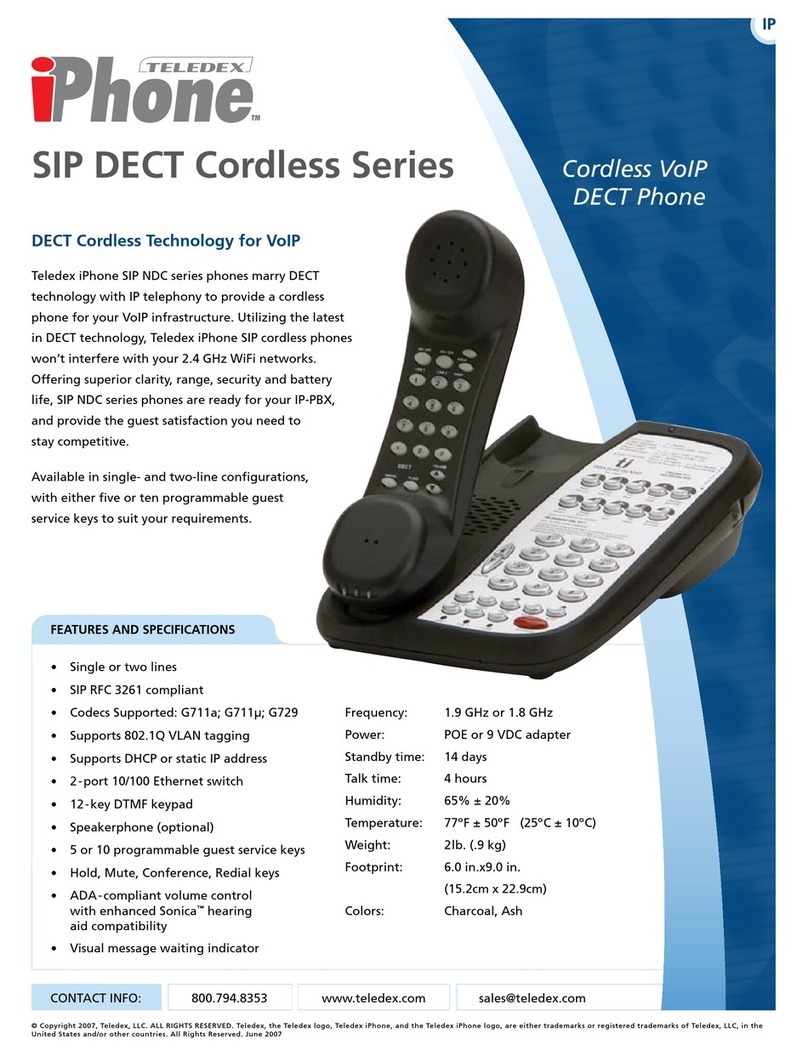
Teledex
Teledex SIP DECT Series User manual
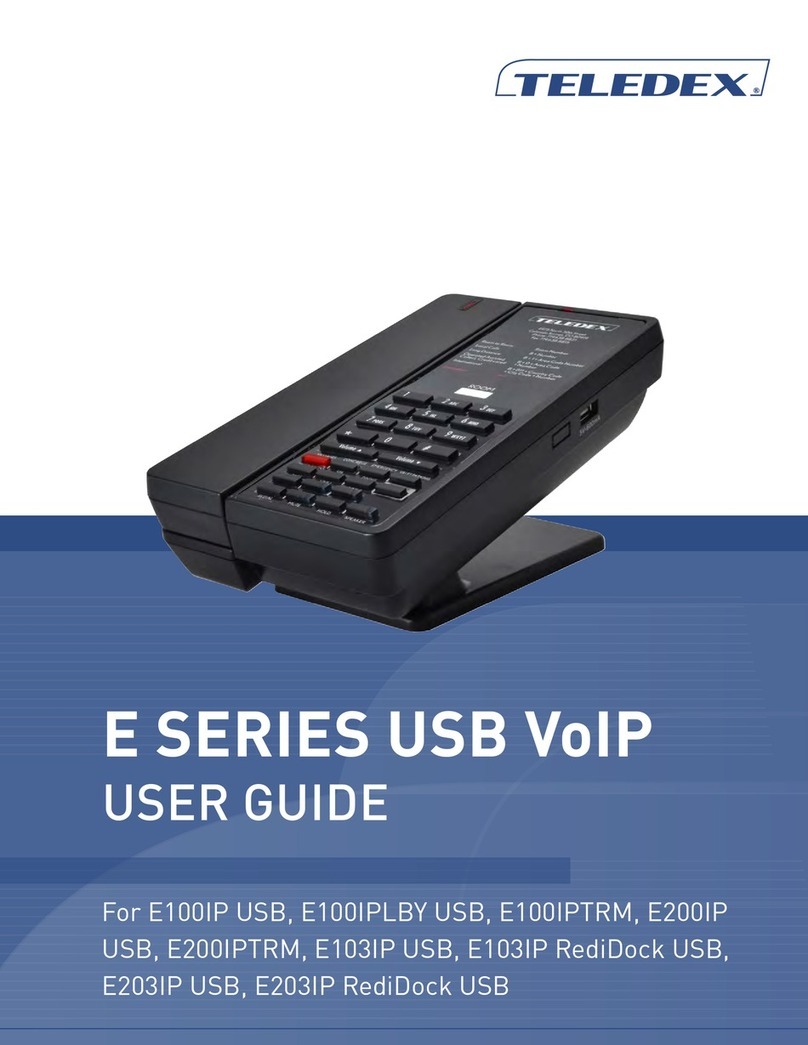
Teledex
Teledex E100IP USB User manual

Teledex
Teledex E103IP RediDock User manual

Teledex
Teledex DIAMOND SERIES User manual
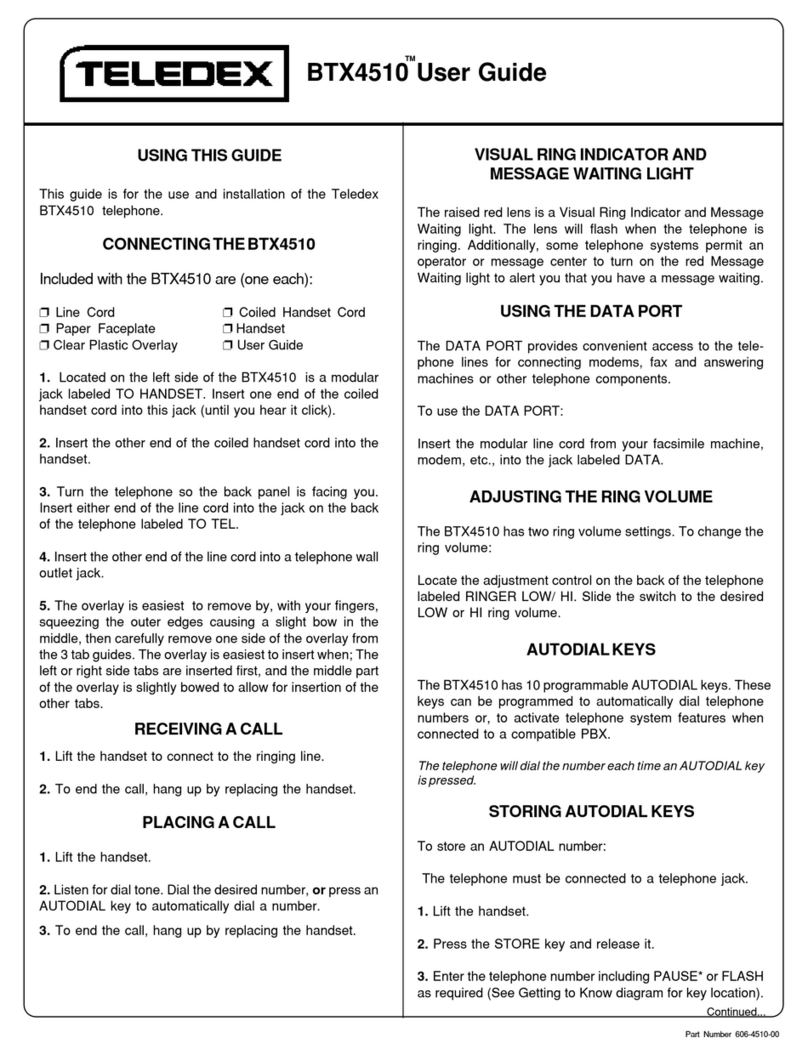
Teledex
Teledex BTX4510 User manual
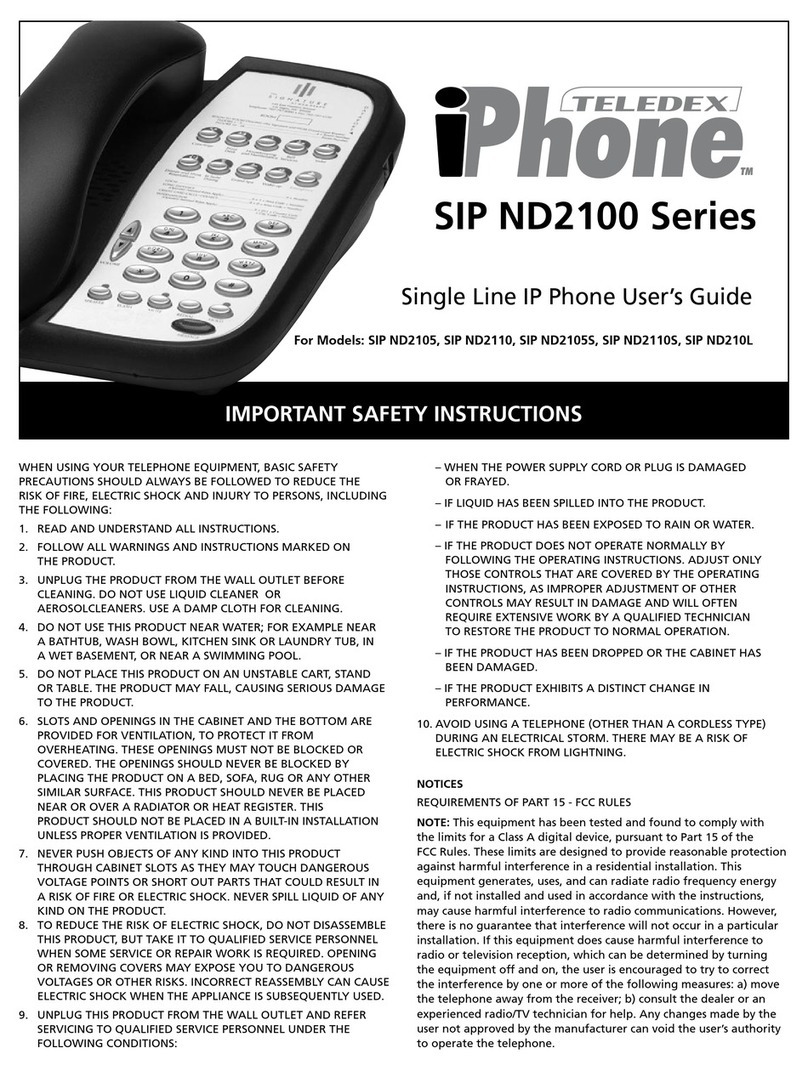
Teledex
Teledex iPhone SIP ND2100 Series s User manual
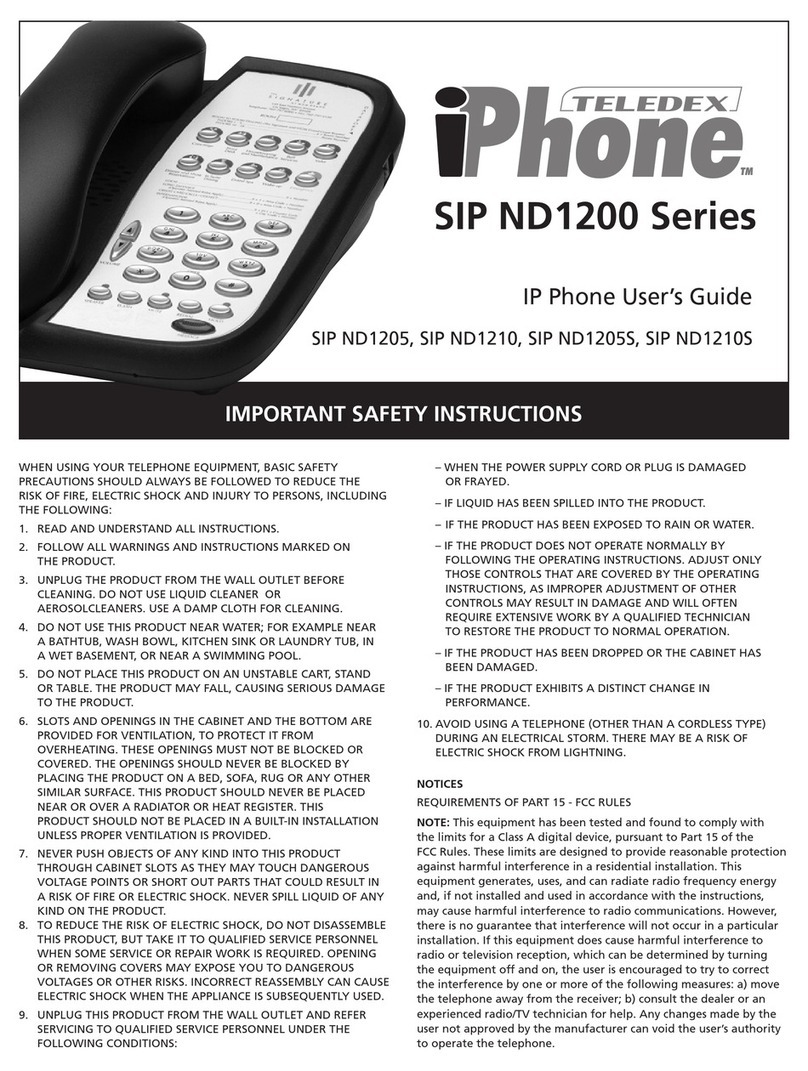
Teledex
Teledex iPhone SIP ND1205 User manual
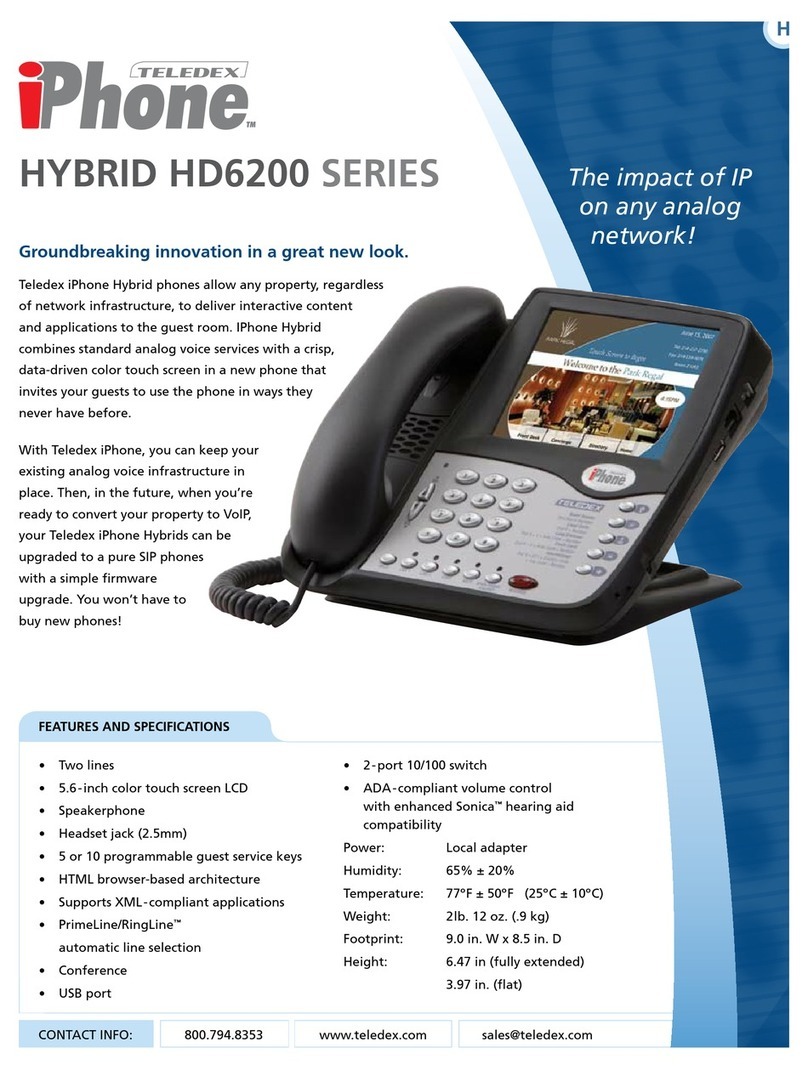
Teledex
Teledex iPhone Hybrid HD6200 series User manual
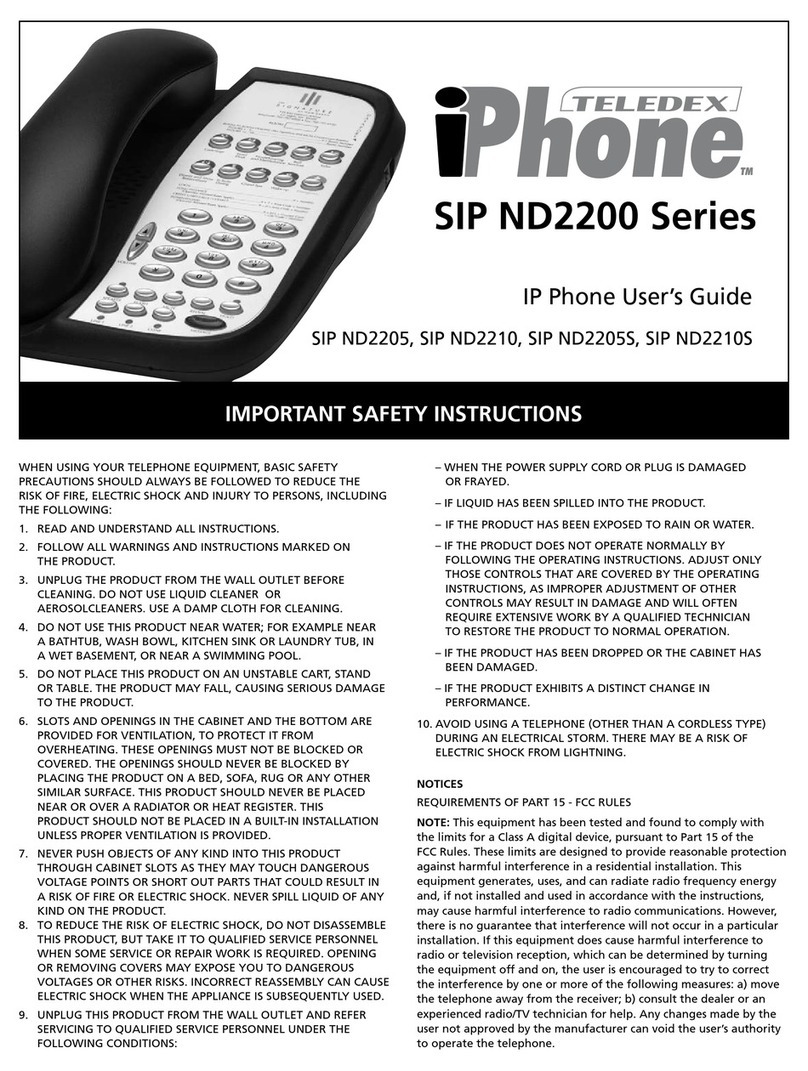
Teledex
Teledex iPhone SIP ND2205 User manual
